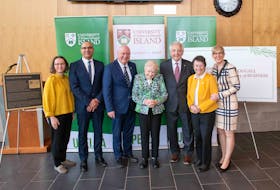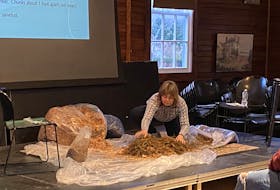BELLEVILLE, Ont. — Heather Brady was shocked, after years of misdiagnosis, when a doctor told her that she has a gene mutation connected to a rare condition with origins in Newfoundland and Labrador.
The Belleville, Ont., woman contacted The Telegram after seeing a story about a Cambridge, Ont., woman diagnosed with hereditary apastic ataxia — linked genetically to certain families originating from this province. In that case, Jackie Thomas was originally from Newfoundland and Labrador.
But Brady, though still filling holes in her genealogy, is doubtful she has a family connection to this province, although distant ancestors may have a Viking link.
She and her parents and grandparents were born in Quebec, she said.
Still, after being told she had other conditions over the years and feeling the effects of medications given to treat diseases she did not have, Brady accepts she has the mutation of the VAMP1 gene, which is connected to certain Newfoundland families.

A was competitive gymnast in her teens, and began having symptoms at the age of 43, she said. She had lost a child in pregnancy and was working three jobs at the time, dropping one to focus on her health, she said.
“I started tripping and my foot would drop more frequently,” Brady said via email, as her speech is severely affected by the condition.
“I thought it was age creeping up on me.”
Since she got referred to a genetic specialist this summer and received her diagnosis in August, Brady, now 55, has been tirelessly studying journals and medical findings posted online, she said.
By 50, she had a walker, and now uses an electric wheelchair and has severe spasticity and pain in her legs.
Brady contacted The Telegram because she fears — based on her past experience of having three different diagnoses — that others with the condition are being misdiagnosed.
The mystery of her suffering was solved, she said, when her doctor attended a conference and drew her case to the attention of a genetics expert. Brady was tested, with results confirming the mutation.
“It scares the bejeesus out of me,” she said in a phone interview, noting she has urged her children to get tested.
“I’m shocked. I don’t know where it originates from.”
She hopes she will connect with others with the condition to join a support group.
According to Memorial University’s Gazette in 2012, the genetic cause of the disease was identified by researchers in Montreal, based on collaboration with researchers and clinicians at
Memorial University's faculty of medicine.
The condition is characterized by lower-limb spasticity (or stiffness) and ataxia (lack of co-ordination), the latter leading to speech and swallowing problems, and eye movement abnormalities, the Gazette reported. People start developing gait problems between 10 and 20 years of age, walk with a cane in their 30s and, in the most severe cases, are wheelchair-bound in their 50s. It is not life-threatening.
The gene harbouring the mutation is VAMP1, encoding the synaptobrevin protein, and was discovered at the Guy Rouleau Laboratory in Montreal in collaboration with MUN researchers and others.
The scientific paper on VAMP1 in 2012 pinpointed the condition to three large Newfoundland families. In total, 50 members of those families were followed by the researchers.
Twitter: @BarbSweetTweets









